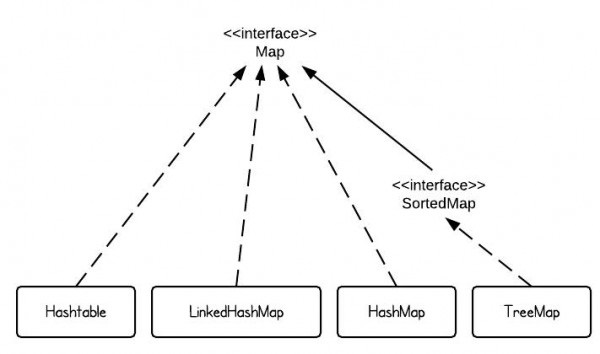Map是一個重要的數據結構,本篇文章將介紹如何使用不同的Map,如HashMap,TreeMap,HashTable和LinkedHashMap。

Java中有四種常見的Map實現,HashMap,TreeMap,HashTable和LinkedHashMap,我們可以使用一句話來描述各個Map,如下:
如果HashMap的Key是自己定義的對象,那麼一般需要覆蓋equals()和hashCode()方法,且要遵循他們之間的約定。
package simplejava;
import java.util.HashMap;
import java.util.Map.Entry;
class Dog {
String color;
Dog(String c) {
color = c;
}
public String toString() {
return color + " dog";
}
}
public class Q26 {
public static void main(String[] args) {
HashMap<Dog, Integer> hashMap = new HashMap<Dog, Integer>();
Dog d1 = new Dog("red");
Dog d2 = new Dog("black");
Dog d3 = new Dog("white");
Dog d4 = new Dog("white");
hashMap.put(d1, 10);
hashMap.put(d2, 15);
hashMap.put(d3, 5);
hashMap.put(d4, 20);
//print size
System.out.println(hashMap.size());
//loop HashMap
for (Entry<Dog, Integer> entry : hashMap.entrySet()) {
System.out.println(entry.getKey().toString() + " - " +
entry.getValue());
}
}
}
結果輸出:
注意,我們不小心添加了兩個"white dogs“,但是HashMap仍然存儲它。這是不合理的,現在我們困惑到底有多少條白狗存入了HashMap,5還是20呢。
其實,Dog類應該是這樣定義的:
class Dog {
String color;
Dog(String c) {
color = c;
}
public boolean equals(Object o) {
return ((Dog) o).color.equals(this.color);
}
public int hashCode() {
return color.length();
}
public String toString() {
return color + " dog";
}
}
結果輸出:
原因是因為HashMap不允許兩個相同的元素存入,默認情況下,Object的hashCode()和equals()會被用於判斷兩個對象是否相同。默認的hashCode()方法對於不同的對象會返回不同的值,而equals()方法只有當兩個引用相等,即指向同一個對象的時候才返回true。如果你不是很清楚,可以自己檢驗下hashCode()和equals()之間的關系。
舉個例子,可以檢驗下HashMap中最常用的方法,如iteration,print等。
TreeMap是按key排序的,讓我們先看下如下代碼,了解其“按key排序”思想。
package simplejava;
import java.util.Map.Entry;
import java.util.TreeMap;
class Dog {
String color;
Dog(String c) {
color = c;
}
public boolean equals(Object o) {
return ((Dog) o).color.equals(this.color);
}
public int hashCode() {
return color.length();
}
public String toString() {
return color + " dog";
}
}
public class Q26 {
public static void main(String[] args) {
Dog d1 = new Dog("red");
Dog d2 = new Dog("black");
Dog d3 = new Dog("white");
Dog d4 = new Dog("white");
TreeMap<Dog, Integer> treeMap = new TreeMap<Dog, Integer>();
treeMap.put(d1, 10);
treeMap.put(d2, 15);
treeMap.put(d3, 5);
treeMap.put(d4, 20);
for (Entry<Dog, Integer> entry : treeMap.entrySet()) {
System.out.println(entry.getKey() + " - " + entry.getValue());
}
}
}
結果輸出:
由於TreeSet是基於Key排序的,所以作為key的對象需要相互比較,這就是為什麼key需要實現Comparable接口。舉個例子,你可以使用字符串作為Key,因為String已經實現了Comparable接口。
現在,讓我們改變一下Dog,讓它可比較,如下:
package simplejava;
import java.util.Map.Entry;
import java.util.TreeMap;
class Dog implements Comparable<Dog> {
String color;
int size;
Dog(String c, int s) {
color = c;
size = s;
}
public String toString() {
return color + " dog";
}
@Override
public int compareTo(Dog o) {
return o.size - this.size;
}
}
public class Q26 {
public static void main(String[] args) {
Dog d1 = new Dog("red", 30);
Dog d2 = new Dog("black", 20);
Dog d3 = new Dog("white", 10);
Dog d4 = new Dog("white", 10);
TreeMap<Dog, Integer> treeMap = new TreeMap<Dog, Integer>();
treeMap.put(d1, 10);
treeMap.put(d2, 15);
treeMap.put(d3, 5);
treeMap.put(d4, 20);
for (Entry<Dog, Integer> entry : treeMap.entrySet()) {
System.out.println(entry.getKey() + " - " + entry.getValue());
}
}
}
結果打印:
在這個例子中,我們是按dog的size來排序的;
如果"Dog d4 = new Dog("white", 10);"被替換成"Dog d4 = new Dog("white",40);",結果將輸出如下信息:
這是因為當前TreeMap使用compareTo()去比較key,不同的size意味著不同的dogs。
參考java文檔:HashMap與HashTable基本類似,除了非同步和允許null外。
LinkedHashMap是HashMap的子類,意味著它繼承了HashMap的特性,除此之外,LinkedHashMap還保存了插入順序。
讓我們使用同樣的代碼,然後將HashMap替換成LinkedHashMap,如下:
package simplejava;
import java.util.LinkedHashMap;
import java.util.Map.Entry;
class Dog {
String color;
Dog(String c) {
color = c;
}
public boolean equals(Object o) {
return ((Dog) o).color.equals(this.color);
}
public int hashCode() {
return color.length();
}
public String toString() {
return color + " dog";
}
}
public class Q26 {
public static void main(String[] args) {
Dog d1 = new Dog("red");
Dog d2 = new Dog("black");
Dog d3 = new Dog("white");
Dog d4 = new Dog("white");
LinkedHashMap<Dog, Integer> linkedHashMap = new LinkedHashMap<Dog, Integer>();
linkedHashMap.put(d1, 10);
linkedHashMap.put(d2, 15);
linkedHashMap.put(d3, 5);
linkedHashMap.put(d4, 20);
for (Entry<Dog, Integer> entry : linkedHashMap.entrySet()) {
System.out.println(entry.getKey() + " - " + entry.getValue());
}
}
}
輸出結果:
如果我們使用HashMap,結果如下,區別在於沒有保存插入順序:
更多閱讀:ArrayList vs. LinkedList vs. Vector
譯文鏈接:http://www.programcreek.com/2013/03/hashmap-vs-treemap-vs-hashtable-vs-linkedhashmap/